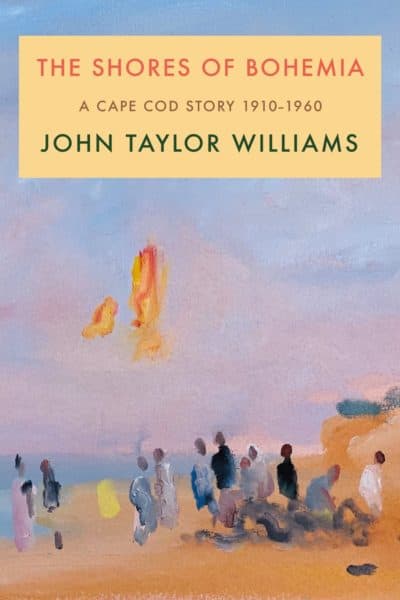Advertisement
Review
In 'The Shores of Bohemia,' an author explores the Cape's history as a creative mecca
“Yes, the honors pile,” wrote the famed art critic Clement Greenberg to a friend, sounding almost exhausted by his success. “But I want gossip, sexual intrigue, back-biting and hair undoing. I want women, confidences, confessions & broken hearts. Dissipation, indiscretions, glitter, dash, sparkles, sin.”
He found all that and more, says author John Taylor Williams, on the outer Cape. In “The Shores of Bohemia: A Cape Cod Story, 1910-1960” (out May 17), Williams takes readers back to a time when the “three towns” — Provincetown, Wellfleet and Truro — were a hotbed of radical thought, avant-garde art and free love, with a cast of bold-faced names who, like Greenberg, piled up accolades in their fields and drama in their personal lives.

The history of the outer Cape as a bohemian mecca dates back to 1898, when the Portland Gale devastated the Provincetown fishing industry and led to a glut of cheap housing that attracted artists and freethinkers interested in a summer respite. Williams attributes the trend to the artist Charles Hawthorne, who founded his painting school there in 1899, and Mary Heaton Vorse, a popular Greenwich Village muckraker who arrived in 1906. In their wake, generations of trailblazers followed: playwrights like Eugene O’Neill and Tennessee Williams, artists like Edward Hopper and Helen Frankenthaler, and exiles like Walter Gropius and Emma Goldman — visionaries who were inspired by new ways of thinking, such as modernism, feminism and socialism, and weren’t afraid of getting in a little trouble if it meant they could have a good time.
Williams divides his book into four sections, each named for one of the seasons to convey the scene’s slow, but gradual decline from the verdant spring of the 1910s and ‘20s to the chilly, mid-century winter, by which time the raucous reds of yesteryear had largely been replaced with a tamer crew of intellectuals and establishment types — and just before the founding of the Cape Cod National Seashore in 1961 drove the final nail in the coffin by turning the outer Cape into a tourist destination for the bourgeois. Along the way, Williams treats readers to a crash course in 20th-century art and politics, and we bear witness to the birth and evolution of modern art, literature and theater, as well as the shifting sands of left-wing thought amid the turmoil of the Red Scare, World War II, and the Cold War.
Williams, a literary agent whose only previously published work is a textbook on publishing law, has an energetic and idiosyncratic style. Each sentence is a journey, dense with information and replete with surprising twists and turns that often take you somewhere you hardly could have expected at the start. He’s always looking for the local angle, too. For instance, when noting that Stalin had exiled Trotsky to Turkey’s Princes Islands in 1929, he introduces Hasan Özbekhan, “a charming professor at the University of Pennsylvania and founder of the Club of Rome,” who “summered in Wellfleet for many years with his wife, Ann, who was the former wife of Paul Rand, the graphic designer who created the IBM logo. Hasan was the last descendant of these hereditary khans who governed the Isle of Princes for the Ottomans.” As run-on sentences go, it sure packs a punch. Overall, the book keeps a frenetic pace, generally chronological, but not shy about jumping back and forth in time to chase down an alluring tangent. There are so many people, and so many trysts, it can be hard to keep up.

Williams married into this history — his wife’s father, the architect Jack Hall, was deeply ensconced in this scene — and his closeness to the subject matter can be a double-edged sword. At his best, Williams’ breathless cavalcade of names and facts communicates the excitement and verve of the bohemian habitués of the outer Cape; occasionally, though, he retreats into tedious listing, as when he rattles off the dozen or so people who attended Mardi Hall’s Easter egg rolling party or the 25 people he names as examples of those in interfaith marriages. “The list could go on for pages,” he writes, and it almost does.
“The Shores of Bohemia'' is eager to pay homage to the legendary work of its brilliant subjects, but at its core, it’s more kaffeeklatsch than salon. While there are thoughtful deep dives into the Bauhaus aesthetic, the emergence of Provincetown as a haven for gays and lesbians, and elaborations on the nuanced political distinctions among the Cape’s Stalinists, Trotskyites, and anarchists, you can tell Williams really enjoys dishing. Sometimes it pushes ahead of the work: Joan Colebrook, who wrote five books and contributed to The New Yorker, is described as being “famous for her erotic connection to men.”
Springing from apparently 54 years’ worth of interviews with many of its subjects and backed with copious research, “The Shores of Bohemia” provides a unique insight into how some of the 20th century’s most compelling figures relentlessly pursued their passions, artistic and otherwise. As winter sets in for good, Williams closes the book with a deeply touching elegy for these “flawed, rowdy, careless bohemians” that really drives home what a special time and special place it was. “The Shores of Bohemia” is a glorious mess, and a fitting tribute to this lost world and all its messy glory.
